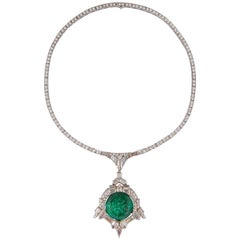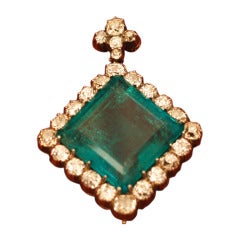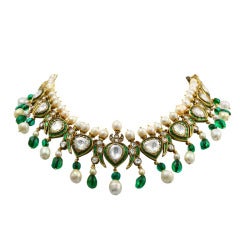Emerald Necklaces
1920s Unknown Art Deco Vintage Emerald Necklaces
Diamond, Emerald, Platinum
20th Century American Emerald Necklaces
Diamond, Emerald, 18k Gold, Platinum, Yellow Gold
Late 19th Century Italian Victorian Antique Emerald Necklaces
Diamond, Emerald, 18k Gold, Sterling Silver
20th Century Indian Emerald Necklaces
Diamond, Emerald, Yellow Gold
Art Deco Emerald Necklaces and Other Vintage Emerald Necklaces for Sale on 1stDibs
Do you have your heart set on a vintage emerald necklace? That’s not surprising — Art Deco emerald necklaces, emerald chokers and other necklaces set with the vibrant stone are sophisticated and glamorous, and that verdant color, and the cachet of wielding a gem beloved and worn by so many queens and princesses (hello, Cleopatra!), could seduce anyone.
Dorothy may have worn ruby slippers, but it was the Emerald City that she was trying to get to. Upon her arrival, she was advised to wear green-tinted eyeglasses to protect her eyes from all the “brightness and glory” in L. Frank Baum’s book The Wizard of Oz. Jewelry lovers born in May can wear their beautiful birthstone, distinguished by its rich green color, on their way to see the Wizard or any other magical place.
While emeralds graced the engagement rings of style icons Wallis Simpson and Jackie Kennedy — and emeralds and yellow diamonds are adding boldness to today’s engagement rings — perhaps no one liked emeralds and emerald jewelry more than Elizabeth Taylor (or her alter ego, Cleopatra).
During the December 2011 auction of Taylor’s jewels that was held at Christie’s, there was a suite of emerald jewels that had been by Bulgari and gifted to the actress by Richard Burton to commemorate their engagement (no celebrity, or civilian for that matter, can rival Taylor in her fervor for Bvlgari). The suite consisted of an emerald and diamond ring, an emerald and flower diamond brooch, an emerald and diamond necklace, an emerald and diamond pendant brooch, a pair of emerald and diamond ear pendants and an emerald and diamond bracelet.
Softer stones — those that score 7 or lower on the Mohs Hardness Scale — are traditionally cut into cabochons since scratches tend to be less noticeable on a cab’s convex surface than on the flat planes of a faceted cut. Emeralds, which register around 7.5 or 8, are commonly cut as cabochons, although the highest-quality examples are often faceted. Thanks to its depth, a cabochon cut can intensify the hue of a colored stone like an emerald, sapphire or ruby. Actress Marlene Dietrich favored cabochon emerald jewelry created by such houses as Paul Flato and Trabert & Hoeffer-Mauboussin. She wore the pieces in press photos, as well as in films like Desire.
New York–based jewelry designer Nina Runsdorf, whose mother and grandmother both had emerald engagement rings, suggests that the stone’s color might appeal to those with an affinity for nature. “My parents left the city when I was 14 and raised us on a farm in upstate New York, so my mother’s love of nature was very strong,” she says. “I think emeralds reminded her of the wild grass and trees.”
Emeralds were first discovered in Egypt around 330 BC. The stone’s name originated from the ancient Greek word for green, “smaragdus.” According to the Gemological Institute of America, “Emeralds from what is now Colombia were part of the plunder when 16th-century Spanish explorers invaded the New World. The Incas had already been using emeralds in their jewelry and religious ceremonies for 500 years. The Spaniards, who treasured gold and silver far more than gems, traded emeralds for precious metals. Their trades opened the eyes of European and Asian royalty to emerald’s majesty.”
There are many important (read: large) emeralds in museum collections around the world. The Patricia Emerald, named after the miner’s daughter, is a 632-carat dihexagonal (or 12-sided) crystal that was discovered in Colombia in 1920 and now resides at the American Museum of Natural History in New York. The Smithsonian Museum of Natural History in Washington has in its possession the Hooker Emerald, a 75.47-carat Colombian stone. That emerald had been acquired in the 16th or 17th century by Spanish conquistadores and shipped to Europe. It later belonged to Abdul Hamid II, Sultan of the Ottoman Empire (1876–1909), who wore it on his belt buckle. Purchased at auction by Tiffany & Co. in 1911, the Hooker Emerald was set into a tiara and featured in the New York World’s Fair “House of Jewels” exhibit in 1940. Today, it is part of a brooch, also designed by the legendary jewelry house.
Find a range of antique and vintage emerald necklaces on 1stDibs.
Read More
A Centuries-Old Style, Lockets Have Never Lost Their Romantic Appeal
Emblems of heartfelt emotion, elegant vessels for photos and keepsakes and perfect for layering, these special ornaments are an essential component of any thoughtfully curated jewelry collection.
This Van Cleef & Arpels Necklace Is an Heirloom in the Making
With more than 100 carats of diamonds, this vintage stunner converts into different styles, making it as versatile as it is breathtaking.
[Survey] Two-Thirds of Jewelry Gift Recipients Don’t Want to Be Surprised
Givers of fine gems enjoy surprise more than receivers, and women more than men. Find out what else our survey of 3,000 Americans revealed.
Next-Level Pearls That Go Well Beyond the Expected
Organic shapes, surprising textures, shimmering colors and inventive embellishments take the new generation of pearl jewelry from classic to cutting-edge.
7 Vibrant Jewels for a Breezy Late-Summer Wardrobe
Soak up the pleasures of the season with a these bold gems.
Whether Worn Alone or Layered, These Chain Link Necklaces Are Trending
Learn more about the stylish links that have passed the test of time.
Meet the Dapper, Mustachioed Parisian Who’s Tops in Crafting Enticing Jewels
After more than a decade creating the iconic Lanvin gems of the Alber Elbaz years, designer Elie Top dove into the world of fine jewelry, mixing silver and gold to create his own striking, timeless look.



